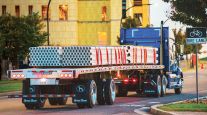Trailer Composites in Focus
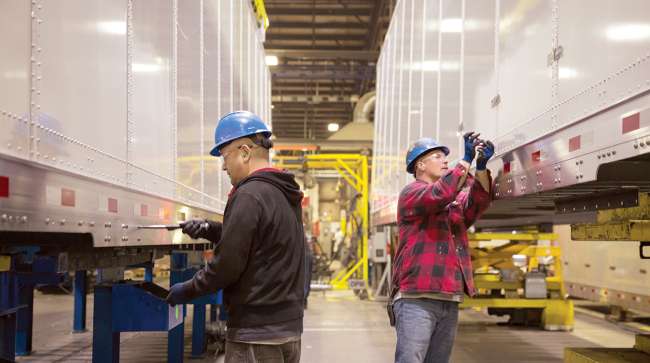
In the endless quest to make trailers lighter, sturdier and more thermally efficient, some trailer manufacturers are expanding their use of composite materials, which could offer the potential for a higher strength-to-weight ratio.
Lighter trailers that last longer would appeal to any fleet, but when composites are used, complicating factors may arise, industry experts said.
Composites can be more expensive than the wood and metal they replace. In addition, the work of repairing damage to composite material is more difficult, and fewer people have the expertise needed to make the repairs.
For years, composite materials have been used in various aspects of trailer construction, but trailer makers are constantly looking for ways to increase their use in their products.
“Composite materials last longer than the foam used for insulation in traditional refrigerated trailer construction,” said Brock Ackerman, vice president, general manager and co-owner at K&B Transportation, a temperature-controlled carrier headquartered in South Sioux City, Neb. “Also, foam tends to soak up water over time and this increases the weight of the trailer.”
K&B will test five of Wabash National’s new “MSC” refrigerated vans, which incorporate a molded-structure composite that includes glass, carbon, foam and resin.
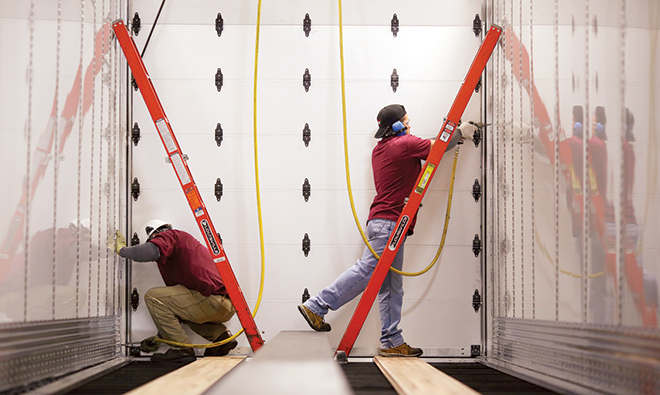
Wabash workers assemble a new trailer. (Wabash National)
“We will have over 100 MSC refrigerated trailers on the road this year and we’ll ramp up production in 2019,” said Robert Lane, Wabash’s vice president of product engineering.
The Wabash MSC trailer walls are smooth, and K&B’s Ackerman noted the advantages: One is reduced product damage.
“Trailers traditionally have construction elements that protrude from the wall,” Ackerman said. “Any time you’re loading a truck with a forklift and pallets are sliding in and out, if there’s anything for the pallet to catch, it will.”
Also, it takes less work to keep smooth walls clean. “There are less nooks and crannies where bacteria can grow,” he said. “It’s easier to sanitize.”
Given the stricter rules on food safety from the U.S. Food & Drug Administration, “this is important,” Ackerman said.
The “big unknown” is repairability, he said. “If the trailer gets a hole torn into the side after rubbing up against a pole, how easy will it be to make a repair?”
In Ackerman’s view, the viability of composite trailers will depend on the infrastructure created by the manufacturers.
“Damage to composite materials is entirely fixable, but it requires a different repair procedure from the repairs made to standard materials,” he said. “Dealerships and repair facilities will need to have technicians who have been trained in this area.”
Wabash’s Lane said that although repairs to the molded-structural composite material are different, they are not necessarily more complex or expensive.

Wabash is introducing trailers that have a molded-structure composite. (Wabash National)
“We’ll be providing our national dealer network and customers with training on proper repair procedures,” he said. “These are well-established repair techniques that have been used in other industries for a very long time.”
K&B generally keeps its reefers for about eight years, Ackerman said. He expects the new Wabash composite trailers to last 10 to 12 years because the composite materials are more durable. “They may be more expensive, but longevity is one way to get the investment back.”
Durability also holds the potential for a higher resale value, which is a priority for R.E. Garrison Trucking, a carrier based in Cullman, Ala.
“When we spec our trailers, we pay attention to the total cost of ownership and that means looking at the resale value,” said Wyles Griffith, president of R.E. Garrison.
The reefers that R.E. Garrison uses have composite flooring to replace the wood stringers underneath the aluminum floors, but that’s been the norm with reefers for several years, Griffith said. He wants to ensure that trailers with expanded use of composites prove themselves before embracing the change.
“In the past, we’d change our trailer specs and try new things,” Griffith said. “Sometimes things would work, but sometimes they didn’t, so we got away from making a lot of changes. Still, if a certain spec seems like a good investment on our part, we’ll go for it.”
Wabash’s goal for the MSC refrigerated trailers is to get up to 25% improvement in thermal efficiency and weight savings of up to 20%, Lane said.
The molded-structure composite replaces the steel, wood and aluminum in the traditional reefer trailer design. “In the floor structure, we’ve taken out the steel cross members and the wood or plastic, and we’ve replaced all of that with a composite panel,” he said.
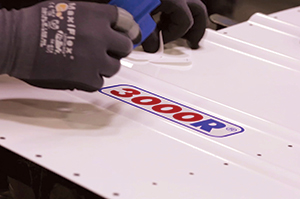
Utility Trailer employee works on a trailer. (Utility Trailer Manufacturing Co.)
It’s a sturdy floor, almost identical to a dry van in terms of the load rating. “This opens the trailer up for more loads on the backhaul,” Lane said.
Craig Bennett, senior vice president of sales and marketing at Utility Trailer Manufacturing Co., said that Utility continues to use aluminum and steel because they are durable and easily repairable.
“Trailers get used and abused, so they have to be able to be repaired easily anywhere that they might get damaged. This is very easy to do with aluminum and steel,” Bennett said.
Utility currently uses hardwood floor fillers for its trailer floors.
“We tested a variety of floor filler material as potential replacements for the wood and nothing survived nearly as well as the wood,” Bennett said. “The screw retention of composites is not nearly as good as wood and steel. If you lose the screw retention in the floor, you’ve lost the floor.”
At Strick Trailers, efforts are always underway to assess and select new materials for trailer constructions, but lighter is not necessarily better, said Charles Willmott, chief sales officer. It depends on the freight being hauled and the operational requirements.
“Lighter weight is always more desirable from a fuel consumption and efficiency perspective but not at the risk of premature equipment failure, excessive maintenance costs or increased safety risks,” Willmott said. “Lightweight features also come with a price penalty most of the time.”
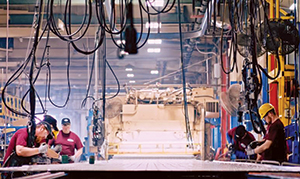
Strick personnel work on a trailer. (Strick Trailers)
Hyundai Translead is another trailer manufacturer that recently announced improvements with composites. A new lightweight dry-van trailer will use panels made with a newly developed composite material.
Two years ago, Hyundai Translead began developing new materials that could replace the composites used for the last 15 years, said Jong Seog Lee, vice president of research and development at the company. Much of the testing has been completed successfully. “The final stage of the endurance test is in progress and will be completed by the end of May.”
Mass production of the trailer is expected to begin in the third quarter, Lee said. The strength is about 20% greater than conventional composite panels, and the weight is reduced by about 250 pounds per 53-foot trailer.
The new panels shouldn’t affect the price significantly. “We are trying to maintain a similar price point to existing technologies for any new lightweight components we develop,” Lee added.
At trailer maker Great Dane, an aluminum alloy is the focus of a current effort. This alloy “has a high strength-to-weight ratio and can be roll-formed to create complex shapes to improve structural integrity and strength,” said Christian Lee, vice president of engineering at Great Dane. “We’re studying the use of this alloy in the design of a new door frame, upper coupler and rails.”
Great Dane also has used carbon fiber composite material to build a prototype trailer that is 2,000 pounds lighter than a conventional trailer. But the challenge is cost. “Carbon fiber is expensive, but we’re working to find ways to reduce the cost,” Lee said.
At Stoughton Trailers, the use of composite materials in the design of reefer trailers is affected by concerns about damage.
“We’ve put composites in places in our new reefer design where they will be less likely to have issues with damage and repair,” said Gary Fenton, vice president of engineering at the trailer maker.
Customers frequently don’t know how to repair damage to composite materials on trailers, Fenton said. That’s why Stoughton decided to use more conventional materials in those areas that have the highest potential for damage.
“Composites are repairable, but the industry as a whole has not addressed the issue,” Fenton said. “We want to find the right balance between gaining the advantages of composites and avoiding the problems that can arise.”
Larry Hall, executive vice president at Premier Trailer Leasing, said that his company would be interested in expanded use of composite materials in trailers, if they prove to be more durable than conventional materials.
However, Premier would want to see proof.
“In general, until composite materials are proven, we tend to shy away from them,” Hall said. “We don’t know what the longevity of these materials will be, so we’d prefer to wait and see.”
The trailer choices fleets make can affect their ability to find the right customer.
“Logistics companies and 3PLs who handle food and beverage have to care about the refrigerated trailers that their carriers use,” said Robert Nathan, CEO of Load Delivered Logistics of Chicago.
Load Delivered has customers whose products require trailers that have metal plated floors instead of wood floors, he said. It also participates in the EPA’s SmartWay program that focuses on sustainability and energy efficiency.
The company is “conscious of working with trucking companies who are using lighter materials that reduce fuel consumption and thus reduce greenhouse gases,” Nathan said. “At the same time, we’re not in the business of telling trucking companies which trailers they should or should not buy.”





